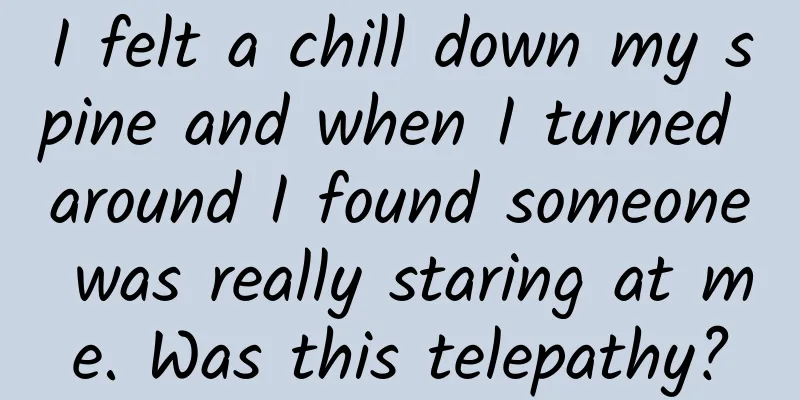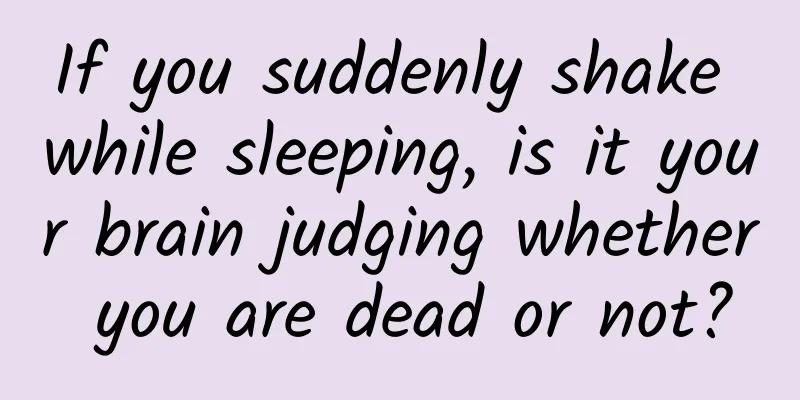I felt a chill down my spine and when I turned around I found someone was really staring at me. Was this telepathy?

|
Have you ever had this experience: you feel like someone is staring at you from behind, and when you turn around, you meet that person's eyes. Is it a coincidence? Or have we humans really evolved the ability to "feel the gazes of others"? Can’t feel it…right? In 1898, British psychologist Edward Titchener published a paper in the journal Science[1] describing this phenomenon for the first time (it was really easy to publish in Science back then). Titchener found that some of the college students he taught firmly believed that they could "feel" someone was staring at them from behind - the focused gaze would cast a kind of pressure, causing a sense of tension or stiffness on the back of the neck, and sometimes a slightly painful tingling sensation. This feeling became stronger and stronger and the area became larger and larger until people had to turn their heads to see who was staring at them. However, after doing some simple experiments, Titchener concluded that it is not because of being "watched" that one has a "feeling". The whole process is more like a self-fulfilling prophecy. ① When there is someone behind you, people will feel anxious because they are worried about how others see them. This anxiety makes people feel uncomfortable. Once people focus their attention on a certain part of the body, such as the back of the neck, it is easier to amplify the originally weak feeling in that part. Titchener gave an example. He had a friend who was learning to dance. Every time he needed to turn his back to the coach (even if it was a private coach), he felt uncomfortable. But when he stood behind the coach and knew that the coach couldn't see him, he felt relaxed and relieved. ② When people feel uncomfortable because they think "someone is looking at me", they may make more movements, such as moving the back of their neck, reaching out to touch the uncomfortable part, turning their heads and looking behind them. These movements will attract other people's attention. In other words, it’s not a coincidence that someone is looking at you when you turn your head, it’s just that the cause and effect needs to be reversed. It is not because someone is looking at you that you feel uncomfortable, but because you feel uncomfortable, you move a lot, even turn around, so others look at you. It takes about 1 second for you to turn your head, but it only takes about 0.2 seconds for the person behind you to turn his eyes and stare at you. In 1913, another related study was published in the American Journal of Psychology [2]. John Coover, a psychologist at Stanford University, came up with a good idea - to randomly decide when to "stare at someone" by rolling a dice. If the dice was an odd number, he would stare at the person for 15 seconds; if the dice was an even number, he would not stare at the person. Before the start, Coover would tap the person once with a pencil, and at the end, he would tap the person twice with a pencil. The "stared person" with his back to Coover would then have to guess whether he was being stared at during this period. The result was that 10 people each guessed 100 times, a total of 1,000 times, and the correct guess rate was only 50.2%, which was no different from a blind guess. Coover's research once again showed that people cannot correctly judge "when someone is watching them." It seems that the conclusion has been reached, but the matter is not completely over. Did you feel it subconsciously? Someone else proposed a possibility: that it is felt, but it only stays at the subconscious level and does not reach the consciousness, so it cannot be judged correctly. In 1993, William Braud improved the research[3][4]. He felt that people might be too nervous when being studied, and coupled with uncertainty in their hearts, they might ignore the subtle signals they received. So, Braud got inspiration from the polygraph and tied some electrode sensors to the subjects to record the fluctuations of physiological signals in the subjects. He chose to measure electrodermal activity (EDA), which is related to emotions, is not controlled by consciousness, and is regulated autonomously by the sympathetic nervous system. Browder also completely separated the "scorer" and the "scored", with the two people sitting in different rooms and conducting "remote staring" through surveillance cameras. The marker has to perform 10 "marking" moves in total, plus 10 "no marking" moves, each lasting 30 seconds, and the order is random. The person being stared at does not need to do anything, and does not need to guess whether he or she is being stared at. He or she just needs to sit there and let the instrument record his or her physiological signals. The results were shocking: being stared at was significantly correlated with strong arousal of skin electrical activity. These two people were in different rooms and only "saw" each other through the camera. Can the results of this experiment be replicated? Interestingly, whether or not a result can be replicated is related to the background of the researcher. If you believe in it, it works; if you don’t believe in it, it doesn’t work. People from parapsychology (the study of supernatural phenomena) research institutes are more likely to replicate the results. Psychologists who are skeptical themselves often come to the conclusion that “there is no effect”. In 2004, American and German researchers published a review in the British Journal of Psychology [5]. They collected 40 relevant studies from 1977 to 2000. After excluding four studies of poor quality, the remaining 36 studies were weighted and analyzed based on research quality. The conclusion was that "long-distance gazing" would trigger certain physiological reactions. However, if only the seven studies with the best quality were analyzed, it was shown that "long-distance gazing" had no effect. This review concludes that no conclusions can be drawn at present and that more high-quality research is needed in the future. Why do we feel like we are being watched? Whether the "feeling of being watched" is a real feeling of the external environment or an illusion spontaneously generated by the brain, it can be explained by evolution. Many people talk about the feeling of looking at or being looked at by animals. Pet owners often feel that their cats and dogs are being looked at. Some wildlife photographers believe that animals are aware of this, even when viewed through a telescope. Naturalist William J. Long once wrote of his own feelings while sitting alone in the woods as a young man: "I often had this feeling that something was watching me. Again and again it came over me before I saw anything. When I looked about me I almost always saw some bird, fox, or squirrel, which had probably noticed that I had turned my head, and had crept up to look at me curiously."[6] Evolutionarily, this feeling has certain benefits. When we think we are being watched by wild animals, we may be more cautious, move lightly, stay alert and hide ourselves, thereby reducing our risk of being discovered by predators and increasing our survival rate in the jungle. But if the "feeling of being watched" is not a real telepathy but an illusion, then why does this illusion exist? And there are quite a few people who have this illusion. Coover conducted a survey among Stanford university students and found that 68% of the 146 students in one course had this "sense of being watched", and 85% of the 95 students in another course also had this "sense of being watched". Again, evolutionarily speaking, this illusion has certain benefits. When we think we are being watched, we are more likely to follow the rules and abide by the laws and moral norms of society. These good behaviors make us more likely to be accepted by society and not be expelled from the group, thus increasing our survival rate in the group. But this illusion can also lead to trouble. Psychological researchers have proposed the “spotlight effect”[7] and the “sinister attribution error”[8]. The "spotlight effect" refers to the fact that people always overestimate the chances of their behavior or appearance being noticed by others, and overestimate the influence of their words on others. In our world, we are the absolute protagonists, but in the world of others, we are just an inconspicuous passerby in the background - however, we easily forget this. "Malicious attribution bias" means that when people feel that they are always under the supervision and evaluation of others, they will overestimate the chances of being noticed by others, and therefore tend to think that other people's behavior is "not targeting me" or "deliberately targeting me." For example, if a colleague does not greet you, it may be because the colleague is worried about work or simply did not notice you, but people with "malicious attribution bias" will always think that this is definitely because the colleague has a problem with him. These two biases not only make us more likely to feel that "someone is watching me", but also make us feel that this gaze may be malicious. Conclusion Maybe next time you can find a partner and try this experiment on your own. Whatever the outcome, it will give you a better understanding of the scientific process. As Titchener concluded in his 1898 paper: "In summary, I have tested this "feeling of being stared at" at different times and in different experiments. The subjects either claimed to be able to sense being stared at or to be able to "stare at someone until they turn away in discomfort." The experiments always gave negative results for this perception or ability. ...If the scientific reader thinks that this result is completely predictable and that the experiment is a waste of time, I can only reply that, in my opinion, such an experiment is meaningful in order to break a certain kind of superstition that is widely held among the public. No psychologist with a scientific mind would believe in telepathy. At the same time, the time spent on falsifying telepathy may drive a student to start on the right scientific path, and the time spent on this may be rewarded a hundredfold in future science. " References [1]Titchener, EB (1898). The'Feeling of Being Stared at'. Science, 8(208), 895-897. [2]Coover, JE (1913). "The Feeling of Being Stared at": Experimental. The American Journal of Psychology, 24(4), 570-575. [3]Braud, WG, Shafer, D., & Andrews, S. (1993). Further studies of autonomic detection of remote staring, new control procedures, and personality correlates. Journal of Parapsychology, 57, 391 – 409. [4]Braud, WG, Shafer, D., & Andrews, S. (1993). Reactions to an unseen gaze (remote attention): A review, with new data on autonomic staring detection. Journal of Parapsychology, 57, 373 – 390. [5]Schmidt, S., Schneider, R., Utts, J., & Walach, H. (2004). Distant intentionality and the feeling of being stared at: Two meta-analyses. British Journal of Psychology, 95(2), 235-247. [6]Sheldrake, R. (2005). The sense of being stared at--part 1: Is it real or illusory?. Journal of Consciousness Studies, 12(6), 10-31. [7]Gilovich, T., Medvec, VH, & Savitsky, K. (2000). The spotlight effect in social judgment: an egocentric bias in estimates of the salience of one's own actions and appearance. Journal of personality and social psychology, 78(2), 211. [8]Kramer, RM (1994). The sinister attribution error: Paranoid cognition and collective distrust in organizations. Motivation and emotion, 18(2), 199-230. [9]Waytz, A. (2013). The Feeling of Being Stared At. Retrieved from https://blogs.scientificamerican.com/moral-universe/the-feeling-of-being-stared-at [10]Psychic staring effect - Wikipedia. Retrieved fromhttps://en.wikipedia.org/wiki/Psychic_staring_effect Author: You Shiyou Edit: Small towel Cover image source: Pixabay Guokr (ID: Guokr42) If you need to reprint, please contact [email protected] Welcome to forward to your circle of friends **Source:** Guokr |
<<: Who is your best friend? Green Peacock: Ox!
>>: If I have a cold or flu, will the nucleic acid and antigen tests be positive?
Recommend
The "Second Uncle" in the scientific community: He turned a disaster into a blessing twice and eventually became a great scientist
A video describing the past half of the life of t...
How much does it cost to make Baidu entries for an enterprise?
For users, Baidu Encyclopedia is an online encycl...
What?! The Earth's rotation has slowed down, and in 5 years, one minute will only be 59 seconds?
Recently, some media reported that: Five years fr...
The traffic secrets of 101 Xiaohongshu recommendation notes!
Why 101 articles? Because one more article is a w...
How much does it cost to customize the Zaozhuang coupon mini program? Zaozhuang coupon applet customized price inquiry
How much does it cost to customize the Zaozhuang ...
Behind the huge success of "Traveling with the Phoenix", how much do you know about the historical image of the phoenix?
Phoenix The recent ancient puppet drama "Tra...
How good are the Chinese in growing vegetables? Rice can be grown in space!
On the afternoon of July 24, 2022, the Wentian ex...
It's time to clarify these six misunderstandings! Unveiling the mystery of psychiatric wards
According to the World Mental Health Report relea...
Operational tips: How to use new media to promote products
Before explaining new media operations, let’s fir...
National Memorial Day丨We will never forget the grief of our country!
84 years ago today Japanese invaders capture Nanj...
What big news did Microsoft make yesterday?
Yesterday was a very special day for people like ...
How to use the Golden Circle Rule to write a marketing promotion plan?
Double 11, Double 12, Christmas Eve and other fes...
Between the two generations of iPhone SE, Apple has quietly changed
After four years, Apple finally released the new ...
Live | B&Q front-end architect Chen Guoxing: How to build isomorphic applications using React
[51CTO.com original article] With the development...
"Bebejia" continues to penetrate deeper, "Prasang" is about to land! Why are autumn typhoons so frequent this year?
At 10:00 today (17th), the Central Meteorological...









